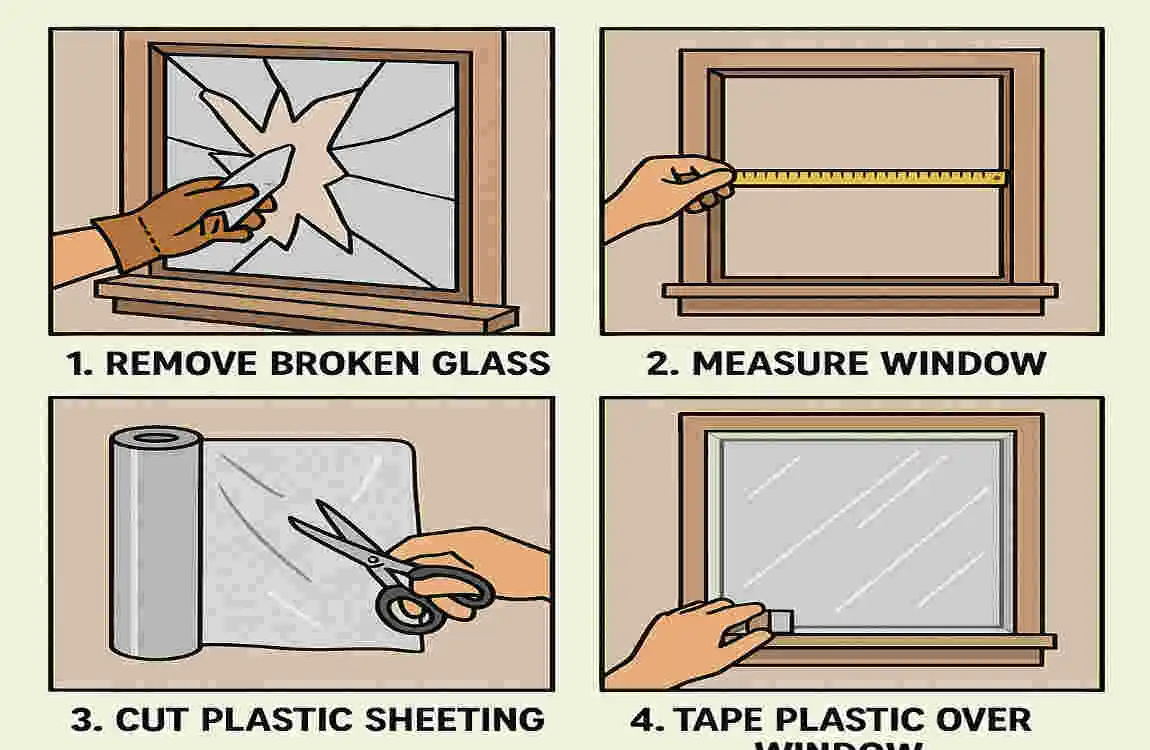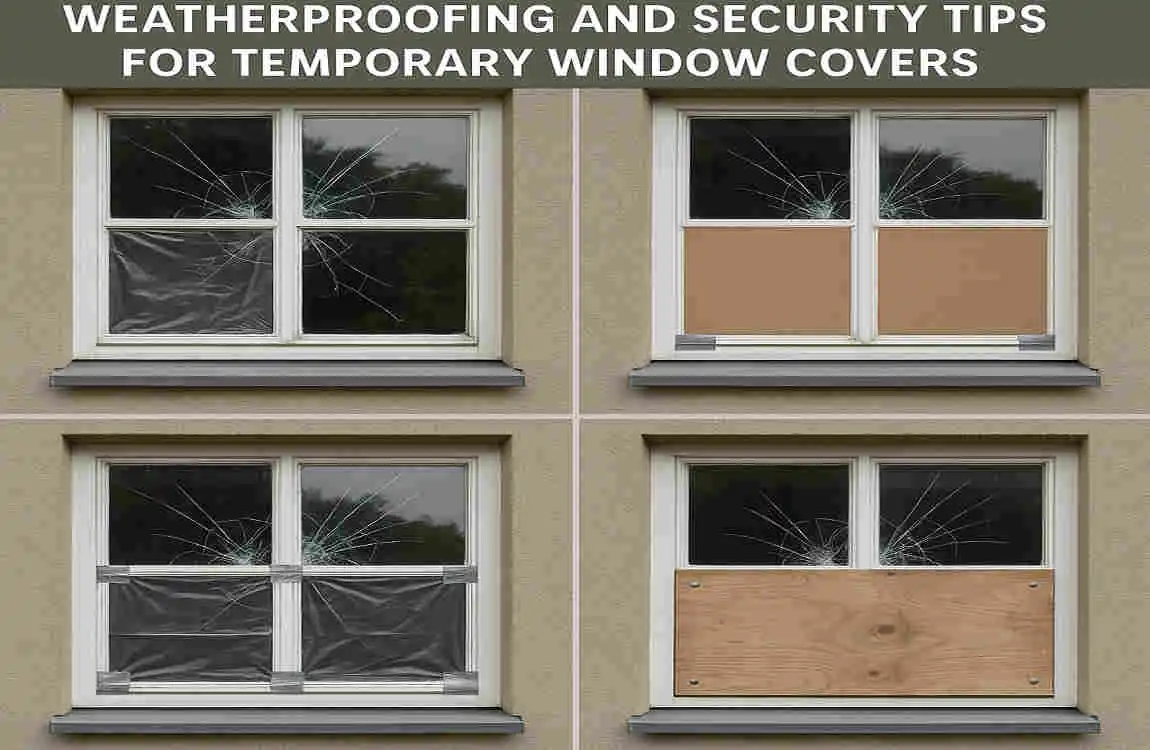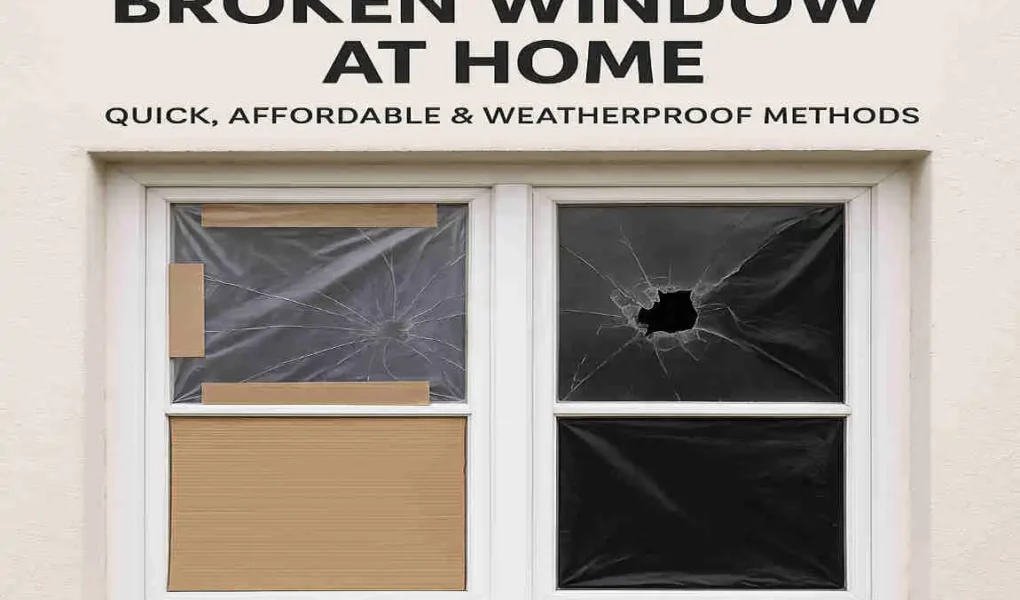A broken window is more than just an inconvenience—it’s a potential hazard to your home and family. Whether the glass is cracked or completely shattered, leaving a broken window exposed can pose security risks, lead to energy loss, and even cause water damage.
While professional window repair is the ideal solution, it’s not always possible to address the issue immediately. That’s where DIY solutions come in handy. With a bit of creativity and the right materials, you can temporarily patch up a broken window, making it secure, weatherproof, and cost-effective.
Understanding the Urgency of Covering a Broken Window

Risks of Leaving a Broken Window Exposed
A broken window exposes your home to several risks, including:
- Weather Damage: Rain, wind, and extreme temperatures can easily enter through a broken window, causing damage to your home’s interior.
- Security Concerns: An uncovered window is an open invitation for burglars or intruders. It compromises the safety of your family and belongings.
- Energy Loss: Broken windows result in drafts, leading to higher energy bills as your heating or cooling system works harder to maintain indoor temperatures.
The Importance of Temporary Coverings
DIY coverings act as a temporary barrier until professionals can repair or replace the window. They help to:
- Insulate your home and keep it comfortable.
- Protect against further damage by sealing off the broken area.
- Enhance security by creating a sturdy cover.
While these solutions are temporary, they’re crucial for mitigating risks and buying time until a permanent fix is possible.
Essential Materials and Tools for DIY Window Covers
Before you begin, gather the following materials and tools to create an adequate window cover:
Common Materials for Temporary Covers
- Plastic Sheeting (heavy-duty or clear): Ideal for weatherproofing and sealing.
- Cardboard: A quick and affordable option for minor damage.
- Plywood: A durable and sturdy material for larger openings.
- Tarps: Great for covering large areas and offering weather resistance.
- Duct Tape: Essential for securing materials and sealing gaps.
Necessary Tools
- Measuring Tape
- Utility Knife or Scissors
- Screwdriver or Drill
- Nails or Screws
- Staple Gun
Tips for Selecting Materials
Choose materials that are:
- Weather-Resistant: Protects against rain, wind, and temperature changes.
- Durable: Sturdy enough to withstand external forces like wind.
- Easy to Work With: Can be cut, shaped, and secured without specialized tools.
Step-by-Step DIY Methods to Cover a Broken Window in the Home

Using Plastic Sheeting or Heavy-Duty Tarp
Plastic sheeting and tarps are excellent options for quickly covering a broken window. They’re lightweight, weatherproof, and easy to install.
Steps:
- Measure the Window Opening: Use a measuring tape to determine the dimensions of the broken window.
- Cut the Material: Cut the plastic sheeting or tarp about 2 inches larger than the window opening on all sides to allow for overlap.
- Secure the Cover: Attach the material to the window frame using heavy-duty duct tape, a staple gun, or nails.
- Check for Gaps: Ensure the edges are sealed to prevent drafts or water leaks.
Benefits:
- Quick and easy to install.
- Lightweight and weatherproof.
- Ideal for small cracks or moderate damage.
Applying Cardboard or Plywood Boards
For larger or entirely shattered windows, cardboard or plywood provides a sturdy, reliable temporary fix.
Steps:
- Measure and Cut: Measure the window opening and cut the cardboard or plywood to fit snugly.
- Secure the Panel: Attach the panel to the window frame using nails, screws, or heavy-duty tape.
- Add Insulation: For better insulation, place a layer of blankets or towels behind the panel before securing it.
- Seal the Edges: Use duct tape to seal around the edges, preventing drafts.
Advantages:
- Provides a strong barrier against wind and rain.
- Suitable for larger openings or completely missing panes.
Pro Tip:
For enhanced durability, paint plywood with waterproof paint to protect it from moisture.
Tape Solutions for Minor Cracks or Damage
If the glass is cracked but still intact, tape solutions offer a quick and straightforward fix.
Steps:
- Clean the Glass: Remove any debris or loose shards around the cracks.
- Apply Tape: Use duct tape or packing tape to cover the crack on both sides of the glass.
- Reinforce: For added protection, apply multiple layers of tape over the affected area.
Limitations:
- Only suitable for minor cracks.
- Not weatherproof or secure enough to withstand significant damage.
Additional Quick Fixes and Enhancements
- Plastic Bags: Use thick plastic bags to seal smaller gaps or holes.
- Double Layering: Apply two layers of material (e.g., plastic sheeting) for extra insulation.
- Draft Sealing: Use weatherstripping or foam tape around the edges for maximum protection.
Weatherproofing and security Tips for Temporary Window Covers

Weatherproofing Tips
- Seal Edges: Use duct tape or silicone caulk to seal all edges and gaps.
- Reinforce with Screws: Secure plywood or cardboard with screws for a tighter seal.
- Double-Layer Protection: Add an extra layer of material for better insulation.
Enhancing security
- Install temporary locks or latches to secure the cover.
- Use curtains or blinds over the cover to maintain privacy.
Safety Precautions When Handling Broken Glass and Materials
When dealing with broken windows, safety should be your top priority:
- Wear Protective Gear: Always use gloves and safety goggles to prevent injuries.
- Dispose of Glass Properly: Collect broken glass in a sturdy container, such as a cardboard box, and label it as hazardous waste.
- Be Cautious with Tools: Handle sharp tools and materials carefully to avoid accidents.
When and How to Transition from DIY Covers to Permanent Repair

While DIY solutions are effective in the short term, they’re not meant to replace professional repairs.
Signs It’s Time for Permanent Repair
- The temporary cover has deteriorated or no longer provides adequate protection.
- Severe weather conditions expose the limitations of temporary fixes.
- The damage affects the structural integrity of your window or home.
Professional Repair Options
- Contact a licensed window repair technician for a long-lasting solution.
- Explore energy-efficient window replacements to reduce future heating and cooling costs.
Cover a Broken Window of Home: FAQ
Why is it important to cover a broken window immediately?
Covering a broken window promptly is crucial for several reasons:
- Weather Protection: Prevents rain, wind, and debris from entering your home .
- Energy Efficiency: Stops drafts and reduces energy loss, especially during colder months .
- Security: Protects your home from potential intruders by creating a temporary barrier.
- Safety: Prevents injuries from loose or falling glass shards .
What materials can I use to cover a broken window?
There are several affordable and accessible materials you can use to temporarily cover a broken window:
- Plastic Sheeting or Tarp: Durable, weatherproof, and easy to secure .
- Cardboard: A quick and sturdy option for smaller windows .
- Plywood: Ideal for larger openings or fully shattered windows .
- Garbage Bags: A lightweight option for sealing gaps, especially in emergencies .
- Bubble Wrap: Adds insulation when layered over plastic sheeting .
What tools do I need for a DIY window cover?
To cover a broken window effectively, you’ll need the following tools:
- Measuring tape
- Utility knife or scissors
- Duct tape or heavy-duty tape
- Screwdriver or power drill
- Nails or screws
- Staple gun (optional)
These tools will help you secure the material tightly to the window frame .
How do I cover a broken window with plastic sheeting or a tarp?
Here’s a step-by-step guide:
- Measure the Window: Measure the dimensions of the broken window.
- Cut the Material: Cut the plastic sheeting or tarp slightly larger than the window opening to allow for overlap.
- Secure the Material: Use duct tape, staples, or nails to attach the material to the window frame. Ensure the edges are sealed to prevent drafts or water leaks .
- Double Layer for Insulation: Add an extra layer of plastic or bubble wrap for better insulation .
Can I use cardboard or plywood to cover a broken window?
Yes, both cardboard and plywood are excellent options for temporary window covers:
- Cardboard:
- Cut the cardboard to fit the window opening.
- Secure it with duct tape or heavy-duty tape.
- Seal the edges to prevent drafts .
- Plywood:
- Measure and cut the plywood to fit snugly.
- Drill screws through the plywood into the window frame for a secure fit.
- Paint the plywood with waterproof paint for added durability .
What’s the best way to handle minor cracks in the glass?
For minor cracks, tape solutions are a quick and effective fix:
- Clean the Glass: Remove any loose shards or debris.
- Apply Tape: Use duct tape or packing tape to cover the crack on both sides of the glass.
- Reinforce: Add multiple layers of tape for extra strength .
This method prevents the crack from spreading and keeps the glass intact temporarily.




